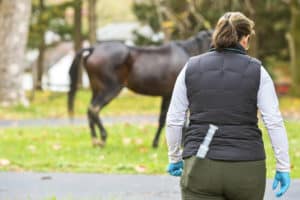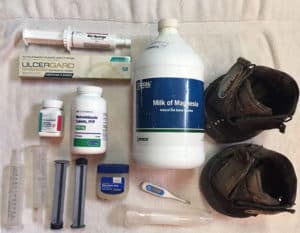Horse Owner Preparation for Hurricanes and Other Natural Disasters
- Topics: Horse Sense (and Sensibility)
Earlier this week an earthquake had news organizations and social media feeds abuzz. Now it’s a Category 2 hurricane named Irene, spinning ominously over the Atlantic and “taking aim at the East Coast of the United States,” according to this morning’s update from the National Weather Service. More than ever I’m reminded of the importance of having a plan for either getting out safely or hunkering down. 
When reporting on the devastation of Hurricane Katrina a few years ago in coastal Louisiana, I stepped over far-flung halters and flat-backed buckets, saw juxtaposed debris (a casket at the door of a church, for example), and spotted the bodies of horses that had become trapped in stalls or debris and drowned during the storm surge or later flooding. The heartache of affected horse owners, rescue teams, veterinarians, and aid workers in the weeks and months following Katrina’s destruction in both Louisiana and Mississippi was so strong I felt I could almost touch it. But so was their determination to help one another, recover, and prepare better for next time: Many strong contingency plans and programs were born out of that disaster, and with each approaching storm more and more horse owners are being proactive about disaster planning.
Here’s how TheHorse.com can help you prepare for hurricanes and other disasters.
- VIDEO: Hurricane Preparedness (helpful tips from Dr. Becky McConnico of Louisiana State University)
- Hurricane Preparation Tips for Horse Owners (From our friends in Louisiana who have been there, done that.)
- I Never Thought it Would Happen to Me… (useful information from Dr. Roberta Dwyer, who’s studied the art of disaster planning)
- Emergency Planning Workbook (Courtesy of EquineU.com)
- Vets Watch for Hurricane-Related Illnesses (information on the illnesses veterinarians see in the wake of hurricanes)
- FACT SHEET: Identification Methods for Horses
- More disaster management articles and information
We ran an update yesterday with interviews from various people in the industry focused on disaster planning and response. We’ll have our eye on Irene and our ear to the ground for updates, although we’re hoping that the storm will not impact horse owners too badly. E-mail our news editor, Erica, with any leads on horse people impacted by Irene; and e-mail our photo/newsletter editor, Megan, with any storm images (including horses) you may capture
Create a free account with TheHorse.com to view this content.
TheHorse.com is home to thousands of free articles about horse health care. In order to access some of our exclusive free content, you must be signed into TheHorse.com.
Start your free account today!
Already have an account?
and continue reading.

Written by:
Stephanie L. Church, Editorial Director
Related Articles
Stay on top of the most recent Horse Health news with














